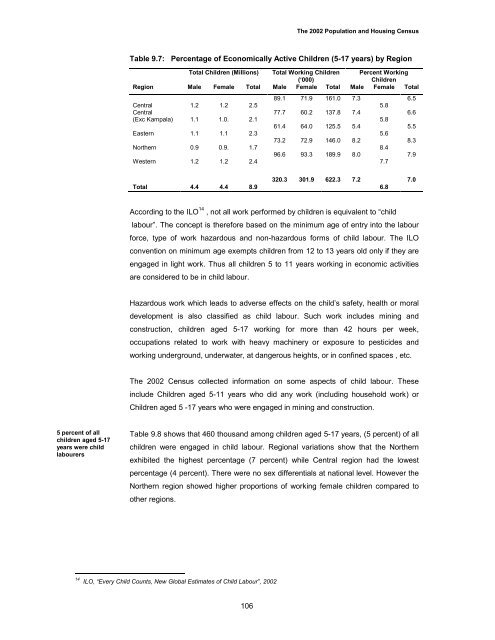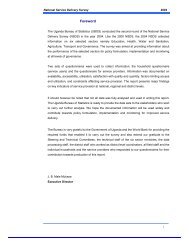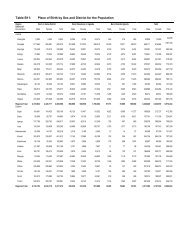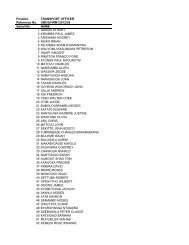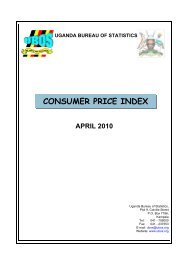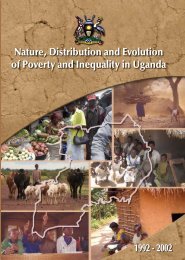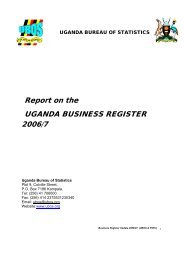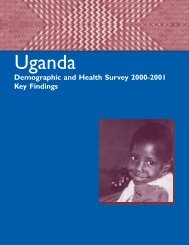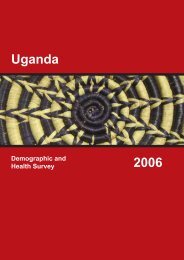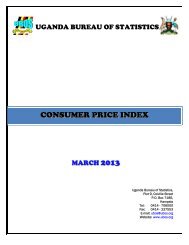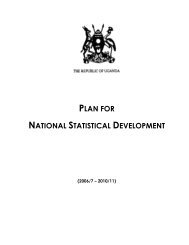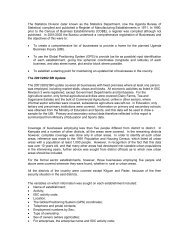Census Analytical Report - Uganda Bureau of Statistics
Census Analytical Report - Uganda Bureau of Statistics
Census Analytical Report - Uganda Bureau of Statistics
You also want an ePaper? Increase the reach of your titles
YUMPU automatically turns print PDFs into web optimized ePapers that Google loves.
The 2002 Population and Housing <strong>Census</strong>Table 9.7: Percentage <strong>of</strong> Economically Active Children (5-17 years) by RegionTotal Children (Millions) Total Working Children(‘000)Percent WorkingChildrenRegion Male Female Total Male Female Total Male Female TotalCentral 1.2 1.2 2.5Central(Exc Kampala) 1.1 1.0. 2.1Eastern 1.1 1.1 2.3Northern 0.9 0.9. 1.7Western 1.2 1.2 2.489.1 71.9 161.0 7.377.7 60.2 137.8 7.461.4 64.0 125.5 5.473.2 72.9 146.0 8.296.6 93.3 189.9 8.05.85.85.68.47.76.56.65.58.37.9Total 4.4 4.4 8.9320.3 301.9 622.3 7.26.87.0According to the ILO 14 , not all work performed by children is equivalent to “childlabour”. The concept is therefore based on the minimum age <strong>of</strong> entry into the labourforce, type <strong>of</strong> work hazardous and non-hazardous forms <strong>of</strong> child labour. The ILOconvention on minimum age exempts children from 12 to 13 years old only if they areengaged in light work. Thus all children 5 to 11 years working in economic activitiesare considered to be in child labour.Hazardous work which leads to adverse effects on the child’s safety, health or moraldevelopment is also classified as child labour. Such work includes mining andconstruction, children aged 5-17 working for more than 42 hours per week,occupations related to work with heavy machinery or exposure to pesticides andworking underground, underwater, at dangerous heights, or in confined spaces , etc.The 2002 <strong>Census</strong> collected information on some aspects <strong>of</strong> child labour. Theseinclude Children aged 5-11 years who did any work (including household work) orChildren aged 5 -17 years who were engaged in mining and construction.5 percent <strong>of</strong> allchildren aged 5-17years were childlabourersTable 9.8 shows that 460 thousand among children aged 5-17 years, (5 percent) <strong>of</strong> allchildren were engaged in child labour. Regional variations show that the Northernexhibited the highest percentage (7 percent) while Central region had the lowestpercentage (4 percent). There were no sex differentials at national level. However theNorthern region showed higher proportions <strong>of</strong> working female children compared toother regions.14 ILO, “Every Child Counts, New Global Estimates <strong>of</strong> Child Labour”, 2002106


